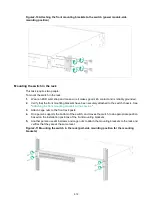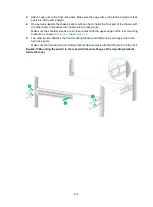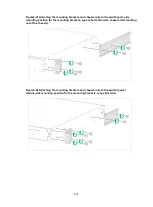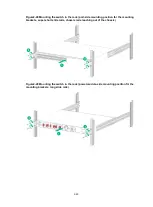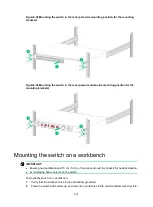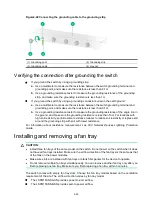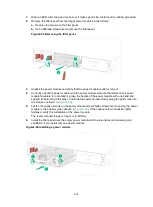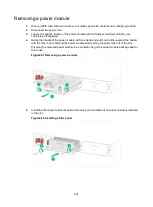
2-21
2.
Install cage nuts in the mounting holes in the rack posts.
3.
Align the screw holes in one slide rail with the cage nuts in a rear rack post. Use M6 screws to
attach the slide rail to the post. See
4.
Repeat the preceding steps to attach the other slide rail to the other rear rack post.
Keep the two slide rails at the same height so the slide rails can attach into the chassis rails.
Figure2-25 Installing the long slide rails
Mounting the switch in the rack
This task requires two people.
To mount the switch in the rack:
1.
Wear an ESD wrist strap and make sure it makes good skin contact and is reliably grounded.
2.
Verify that the mounting brackets and chassis rails have been securely attached to the switch
chassis. See "
Attaching the chassis rails to the chassis
3.
Verify that the slide rails have been correctly attached to the rear rack posts. See "
long or super-short slide rails to the rack
4.
Attach cage nuts to the front rack posts and make sure they are at the same level as the slide
rails.
5.
One person performs the following operations:
a.
Supporting the bottom of the switch, aligns the chassis rails with the slide rails on the rack
posts.
b.
Pushes the switch slowly to slide the chassis rails along the slide rails until the mounting
brackets are flush with the rack posts.
IMPORTANT:
If you use long slide rails to rack-mount the switch, make sure the front ends of the long slide
rails reach out of the chassis rails for a maximum of 20 mm (0.79 in). If you use super-short slide
rails to rack-mount the switch, make sure the front ends of the super-short slide rails reach
inside the chassis rails for a minimum of 110 mm (4.33 in) after installation.
6.
Another person uses user-supplied M6 screws to attach the mounting brackets to the rack.






